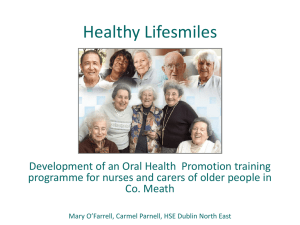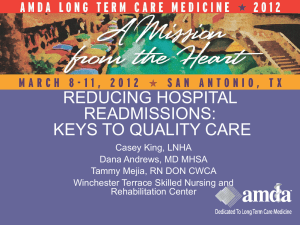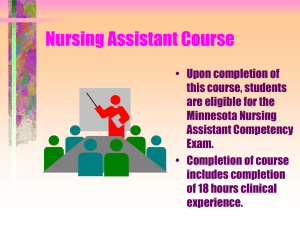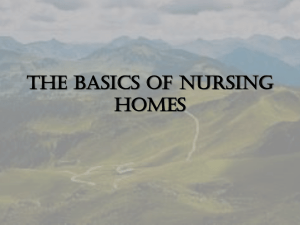File - Amy Long, RN
advertisement
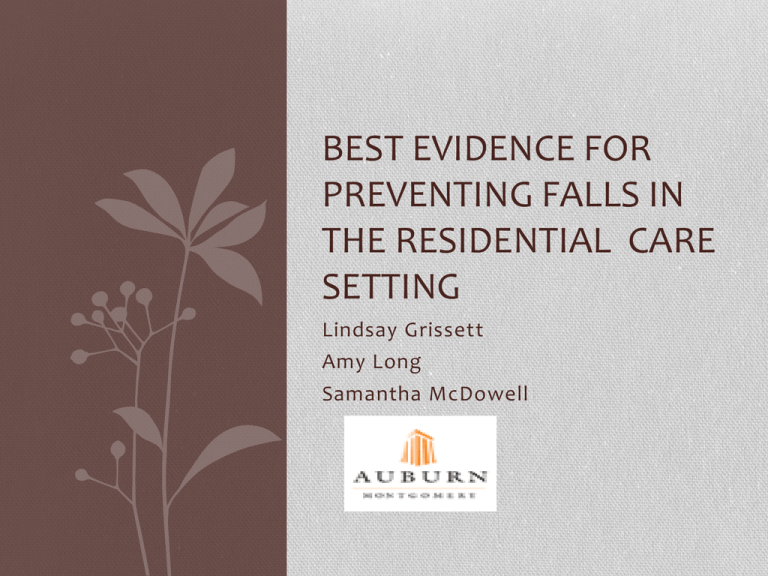
BEST EVIDENCE FOR PREVENTING FALLS IN THE RESIDENTIAL CARE SETTING Lindsay Grissett Amy Long Samantha McDowell INTRODUCTION • Residents in a Nursing Home setting are among the most susceptible for falls. This is a concern for the residents, their families, and the staff. • According the the U.S. Department of Health and Human Services, each year roughly 1800 people living in nursing homes die from sustaining falls (Agency for Healthcare Research and Quality, 2013). • These residents typically suffer from multiple disease processes to include increased muscle weakness, multiple medication uses, and decreased memory. INTRODUCTION (CONT.) MEMORY LOSS • SHORT TERM • LONG TERM • BOTH DECREASED COGNITIVE SKILLS POOR DECISOIN MAKING SKILLS FALLS INTRODUCTION (CONT.) Residents are usually repeat fallers, and will average around 2.6 falls per year with 6% sustaining fractures (Agency for Healthcare Research and Quality, 2013). CASE STUDY • Tiger Terrace Skilled Nursing Facility houses 140 residents, with the majority being ambulatory and having cognitive deficits. • The majority of the nursing staff are Licensed Practical Nurses (LPN). • Tiger Terrace has witnessed a drastic increase in falls over the past six months with many of the residents sustaining hip fractures. • A team consisting of the Director of Nursing (DON), the Assistant Director of Nursing, (ADON), one Registered Nurse (RN) Supervisor, and one LPN assembled in order to research the best falls prevention program in a skilled nursing facility. SITUATION FOCUSED QUESTION • The purpose and goal of this query is to identify a falls prevention program that has been reported as successful in decreasing the number of falls in the nursing home setting where many of the residents have impaired cognition. FOCUS QUESTION The focused question is “What is the highest evidence related to a falls prevention program, that is effective in preventing falls in ambulatory residents with impaired cognition, living in a Skilled Nursing Facility?” TARGET RESOURCES • Various systematic reviews were used to obtain the highest evidence available. • Articles were examined for relevance. • Information that was specific to falls in the nursing home setting where residents had altered levels of cognition was of highest priority. • Goals were set to obtain information containing current data. THE SEARCH •The team utilized the focused question to help guide the search. •The PPAARE method was used to create the focused question. PPAARE PPAARE Component Case Example Problem Increase in falls Patient Ambulatory residents in a skilled nursing facility who are cognitively impaired. Action Falls prevention program Alternative Not applicable Patient Results Decrease the number of falls in the facility. Level of Evidence Highest level of evidence. RELEVANT EVIDENCE • Although nine different sources of information were identified, only 5 were chosen due to relevance related to the PPAARE. • The chosen studies were conducted in the last five years and provided tables that listed cause and effect, as well as statistics necessary to guide the development of a falls prevention program. Falls can be labeled as having causes that are Intrinsic or Extrinsic. Intrinsic- Meaning they are related to factors related to the patient, such as medication. Extrinsic- Meaning they are related to external factors such as a wet floor. INFORMATION THAT WAS FOUND • FALLS COST RESIDENTS MENTAL WELL BEING AS WELL AS PHYSCIAL WELL BEING, ASIDE FROM MONETARY COSTS. • HAVING A WELL INFORMED STAFF IS PERTINENT. • THERE IS A NEED TO IMPROVE DOCUMENTION. • THE IMPORTANCE OF USING A FALLS ASSESSMENT TOOL WAS STRESSED. • A GOLD STANDARD FOR FALL ASSESSMENT TOOLS HAS NOT YET BEEN DEVELOPED. INFORMATION FOUND • DATA GATHERING WAS FOUND TO BE OF HIGH IMPORTANCE CONCERNING IDENTIFYING RESIDENTS AT RISK • QUALITY OF LIFE DECREASES FOR RESIDENTS AFTER A FALL • STUDIES HAVE BEEN DONE USING LAVENDER, WHICH HAS A CALMING EFFECT AND HELPS WITH BEHAVIOR ISSUES. • STUDIES WERE DONE CONCERNING A FULL TIME NURSE TO ASSIST WITH EBP IN THE LONG-TERM CARE SETTING. EVIDENCE APPRAISAL Quantitative Study Study appraised concerned using lavender with olfactory stimulation. • Study found to be strong. • Focused on generalized population of residents 65 and older. • Data measured consistently over one year period. • Funding for the study was unbiased. EVIDENCE APPRAISAL Qualitative Study The study appraised concerned using a Falls Risk Assessment (FRA) tool. • • • • A multi-disciplinary team approach was used in the study. There were no conflict of interest. Interpretation of data used was consistent with actual data. Self-disclosure was made evident. WHAT DID WE LEARN? CHARTING AND DOCUMENTATION NEEDS TO IMPROVE ASSESSMENTS SHOULD TAKE PLACE AT BEDSIDE EVERY PATIENT SHOULD BE ASSESSED ON ADMISSION WHAT DID WE LEARN? • ASSESSMENT TOOLS ARE ONLY GOOD IF THEY ARE USED PROPERLY • LAVENDER MAY HAVE AN EFFECT DECREASING ANXIETY IN RESIDENTS WHICH CAN LEAD TO FALLS • STUDIES AND RESEARCH IS A CONTINUING PROCESS TO FIND ANSWERS TO THE PROBLEM OF FALLS IN THE NURSING HOME SETTING. RESOURCES Lea, E., Andrews, S., Hill, K., Haines, T., Nitz, J., Haralambous, B., Moore, K., & Robinson, A. (2012). Beyond the ‘tick and flick’: Facilitating best practice falls prevention through an action research approach. Journal of Clinical Nursing, 21, 1896-1905. doi: 110.1111/ J.1365-2702.2012.04121.x Sakamoto, Y., Ebihara, S., Ebihara, T., Tomita, N., Toba, K., Freeman, S., Arai, H., & Kohzuki, M. (2012). Fall prevention using olfactory stimulation with lavender odor in elderly nursing home residents: A randomized controlled trial. Journal of the American Geriatrics Society, 60, 1005-1011. doi: 10.1111/j.1532-5415.2012.03977.x U.S. Department of Health and Human Services, (2013). Interdisciplinary team identifies and addresses risk factors for falls among nursing home residents, leading to fewer falls and less use of restraints. Retrieved from Agency for Healthcare Research and Quality website: http://www.innovations.ahrq.gov/content.aspx?id=1835




